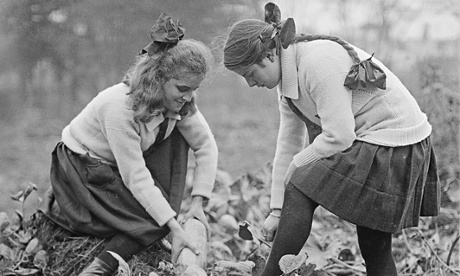
Advice on cooking with a hay box, reusing coal dust to make fire briquettes, creating a black dye for funereal silk from a “decoction of fig leaves” and making “butter” from sieved mashed potatoes. These are first world war activities urged on the home front by both government and newspapers, as a hungry and resource-scarce nation faced the prospect of being starved into submission.
The enthusiasm and resourcefulness displayed by Britons, especially after 1916 when hopes for a short war faded, provided a template for the famous “make do and mend” ethos of the 1940s.
While the slogan was not formalised into propaganda until the 1939-45 war against Hitler, by 1916, people were learning fast how to keep chickens, how to turn villa gardens into potato patches and refreshing clothes with remnants and netting. Villages organised collection points to deliver waste to householders who had volunteered to keep a pig.
Readers’ letters to newspapers provide evidence of ingenious enthusiasm for the national effort. Suggestions range from recipes for making jam without sugar (using honey) and making a savoury jelly out of wild rowan berries, to a proposal to turn London’s garden squares into poultry runs.
The (then Manchester) Guardian was strong on encouraging readers to forage for food. An article on River Fish for the Table in July 1915 tells readers put off by “ill-cooked pike” to try bream and carp instead of scarce meat. Another article in April 1918 reports that in that year wood pigeon, thanks to a bumper acorn season over the winter, are “uncommonly good eating”. Roast seagull, their eggs, and cakes made from bracken root flour are also recommended.
Privations on the home front became severe during the last two years of the war. Lillie Scales, who kept a diary during the war wrote in 1917: “The cakes you buy now are simply horrid. You can make quite nice puddings with potatoes or carrots instead of flour. I have lost two stone since the war began.” The diary of wartime teenager Miss E V Tregellis, now in the Imperial War Museum, makes plaintive reading after March 1917 when she notes grumpily: “We are put on war bread now … everywhere you go there are posters telling you not to eat so much bread.”
Reinvention of the past
Just as the 1940s make do and mend ethos is having a revival today, so the second world war campaign was simply a reinvention from the first, says Susan Grayzel, professor of history at the University of Mississippi and author of Women and the First World War (Routledge). “At the beginning of the first world war, no one anticipated the shortages or rationing ahead,” she says. “The working classes, of course, already knew about how to survive on very little. The middle classes had to learn lessons of scarcity and sacrifice pretty quickly. During the 1930s the state looked at those lessons and began to formulate the make do and mend strategy ready for implementation if another war came.” She adds that for women of the second world war, many whose mothers lived through the first, had grown up with the ideas of thrift and economy through “lived memory” at their mothers’ knee.
This lived memory still resonates down the generations. Kathy Hall, from Long Buckby says: “I find a secret pleasure in finding a second, or even third, use for any item.” Kathy, 70, was brought up by a mother born before the first world war. She says: “I save buttons, string, elastic bands, paper and old envelopes for notes and shopping lists. Old washing-up brushes and tooth brushes are ideal for doing service for household cleaning purposes. When I visited grandma as a child, the toilet was outside, with a water butt to catch the rainwater which was used to flush the loo; waste was considered an incomprehensible sin.” One of her favourite tips is to soak wax jam seals in brandy to inhibit mould growth.
Not all first world war recipes or activities should be encouraged today. The recipe, authorised by the Coal Controller, for making coal dust briquettes out of “cinders, sawdust, small wood chips and 10% of cement, with sufficient water to render the whole plastic” might now cause anxiety. Similarly modern consumers may find potato “butter”: 1oz of margarine mixed with 140z of sieved mashed potato and shaped into a pat, rather hard to swallow. It is now illegal to kill seagulls or disturb their nests.
Hay box, or residual heat cooking, however, is today commonly employed in camping, during power cuts or by particularly thrifty householders.
Lillie Scales’s A Home Front Diary, found among family memorabilia by her great nephew Peter Scales was published this year by Amberley.
Interested in finding out more about how you can live better? Take a look at this month’s Live Better challenge here.
The Live Better Challenge is funded by Unilever; its focus is sustainable living. All content is editorially independent except for pieces labelled advertisement feature. Find out more here.

